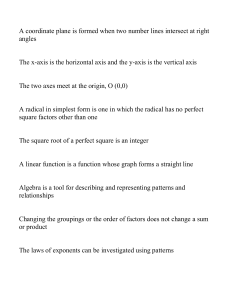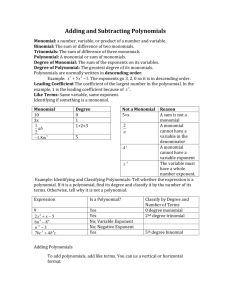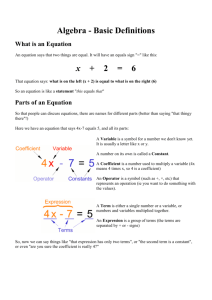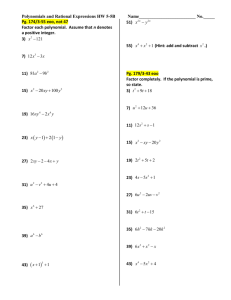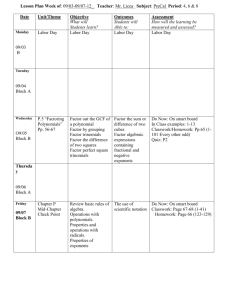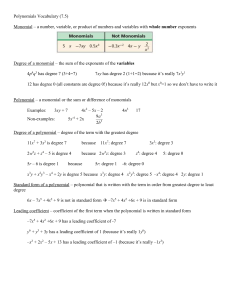093- class 19- review mini-sheet (ch3)
advertisement
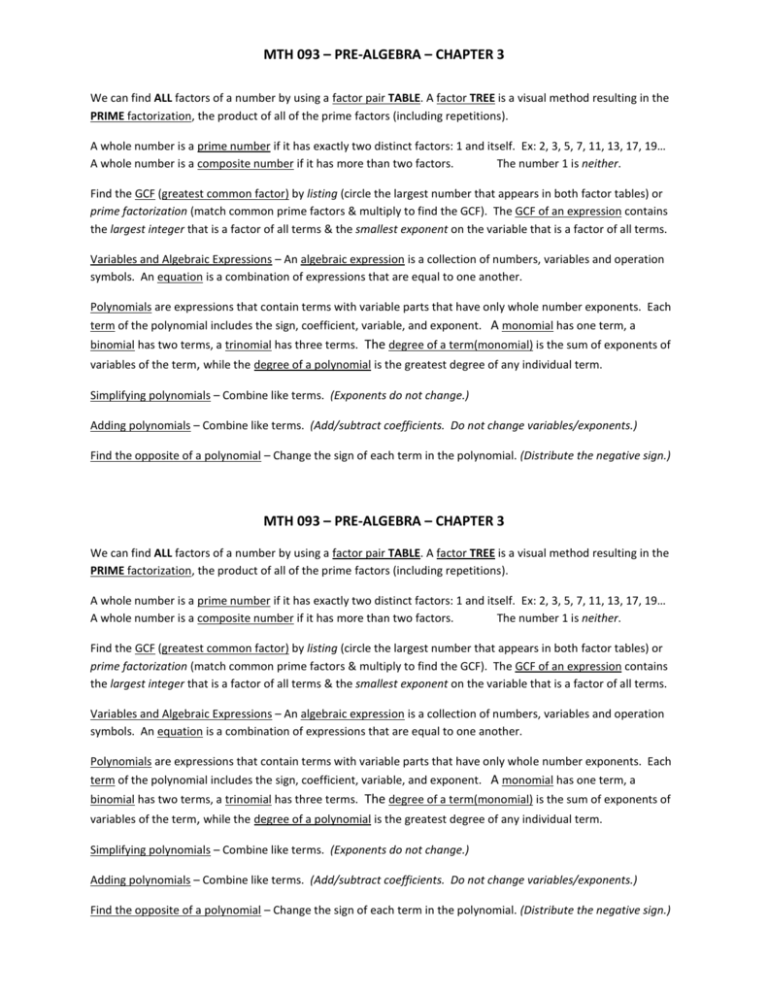
MTH 093 – PRE-ALGEBRA – CHAPTER 3 We can find ALL factors of a number by using a factor pair TABLE. A factor TREE is a visual method resulting in the PRIME factorization, the product of all of the prime factors (including repetitions). A whole number is a prime number if it has exactly two distinct factors: 1 and itself. Ex: 2, 3, 5, 7, 11, 13, 17, 19… A whole number is a composite number if it has more than two factors. The number 1 is neither. Find the GCF (greatest common factor) by listing (circle the largest number that appears in both factor tables) or prime factorization (match common prime factors & multiply to find the GCF). The GCF of an expression contains the largest integer that is a factor of all terms & the smallest exponent on the variable that is a factor of all terms. Variables and Algebraic Expressions – An algebraic expression is a collection of numbers, variables and operation symbols. An equation is a combination of expressions that are equal to one another. Polynomials are expressions that contain terms with variable parts that have only whole number exponents. Each term of the polynomial includes the sign, coefficient, variable, and exponent. A monomial has one term, a binomial has two terms, a trinomial has three terms. The degree of a term(monomial) is the sum of exponents of variables of the term, while the degree of a polynomial is the greatest degree of any individual term. Simplifying polynomials – Combine like terms. (Exponents do not change.) Adding polynomials – Combine like terms. (Add/subtract coefficients. Do not change variables/exponents.) Find the opposite of a polynomial – Change the sign of each term in the polynomial. (Distribute the negative sign.) MTH 093 – PRE-ALGEBRA – CHAPTER 3 We can find ALL factors of a number by using a factor pair TABLE. A factor TREE is a visual method resulting in the PRIME factorization, the product of all of the prime factors (including repetitions). A whole number is a prime number if it has exactly two distinct factors: 1 and itself. Ex: 2, 3, 5, 7, 11, 13, 17, 19… A whole number is a composite number if it has more than two factors. The number 1 is neither. Find the GCF (greatest common factor) by listing (circle the largest number that appears in both factor tables) or prime factorization (match common prime factors & multiply to find the GCF). The GCF of an expression contains the largest integer that is a factor of all terms & the smallest exponent on the variable that is a factor of all terms. Variables and Algebraic Expressions – An algebraic expression is a collection of numbers, variables and operation symbols. An equation is a combination of expressions that are equal to one another. Polynomials are expressions that contain terms with variable parts that have only whole number exponents. Each term of the polynomial includes the sign, coefficient, variable, and exponent. A monomial has one term, a binomial has two terms, a trinomial has three terms. The degree of a term(monomial) is the sum of exponents of variables of the term, while the degree of a polynomial is the greatest degree of any individual term. Simplifying polynomials – Combine like terms. (Exponents do not change.) Adding polynomials – Combine like terms. (Add/subtract coefficients. Do not change variables/exponents.) Find the opposite of a polynomial – Change the sign of each term in the polynomial. (Distribute the negative sign.) MTH 093 – PRE-ALGEBRA – CHAPTER 3 Subtracting polynomials – Find the opposite of the second polynomial, then add. (Add/subtract coefficients. Do not change variables/exponents.) Multiplying Algebraic Expressions – Multiply numerical coefficients. Add the exponents of the common variables. Monomial times a Polynomial – Distribute the monomial to each term of the polynomial. Binomial times a Trinomial –Distribute each term of the binomial to the trinomial. Binomial time a Binomial– Distribute each term of the first binomial to the second binomial. (We often use the shortcut: FOIL – First, Outside, Inside, Last) Difference of Squares: (𝑎 + 𝑏)(𝑎 − 𝑏) = 𝑎2 − 𝑏 2 Dividing Algebraic Expressions – Divide numerical coefficients. Subtract the exponents of the common variables. Polynomial by a Monomial – Divide each term in the polynomial by the monomial. Summary of Exponent Rules (so far) Product rule: 𝑥 𝑎 ∙ 𝑥 𝑏 = 𝑥 𝑎+𝑏 𝑥𝑎 Quotient rule: Power rule: (𝑥 𝑎 )𝑏 = 𝑥 𝑎∙𝑏 Other power rules: (𝑥𝑦)𝑏 = 𝑥 𝑏 𝑦 𝑏 Zero exponent: 𝑎0 = 1, 𝑎 ≠ 0 𝑥𝑏 = 𝑥 𝑎−𝑏 , 𝑖𝑓 𝑎 > 𝑏 & 𝑥 ≠ 0 MTH 093 – PRE-ALGEBRA – CHAPTER 3 Subtracting polynomials – Find the opposite of the second polynomial, then add. (Add/subtract coefficients. Do not change variables/exponents.) Multiplying Algebraic Expressions – Multiply numerical coefficients. Add the exponents of the common variables. Monomial times a Polynomial – Distribute the monomial to each term of the polynomial. Binomial times a Trinomial –Distribute each term of the binomial to the trinomial. Binomial time a Binomial– Distribute each term of the first binomial to the second binomial. (We often use the shortcut: FOIL – First, Outside, Inside, Last) Difference of Squares: (𝑎 + 𝑏)(𝑎 − 𝑏) = 𝑎2 − 𝑏 2 Dividing Algebraic Expressions – Divide numerical coefficients. Subtract the exponents of the common variables. Polynomial by a Monomial – Divide each term in the polynomial by the monomial. Summary of Exponent Rules (so far) Product rule: 𝑥 𝑎 ∙ 𝑥 𝑏 = 𝑥 𝑎+𝑏 𝑥𝑎 Quotient rule: Power rule: (𝑥 𝑎 )𝑏 = 𝑥 𝑎∙𝑏 Other power rules: (𝑥𝑦)𝑏 = 𝑥 𝑏 𝑦 𝑏 Zero exponent: 𝑎0 = 1, 𝑎 ≠ 0 𝑥𝑏 = 𝑥 𝑎−𝑏 , 𝑖𝑓 𝑎 > 𝑏 & 𝑥 ≠ 0
